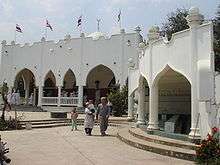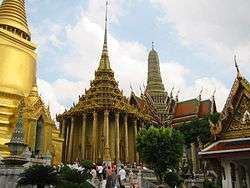Religion in Thailand

Religion in Thailand is varied. There is no official state religion in the Thai constitution, which guarantees religious freedom for all Thai citizens, though the king is required by law to be Theravada Buddhist.[1] The main religion practiced in Thailand is Buddhism, but there is a strong undercurrent of Hinduism with its distinct priestly class.[2] The large Thai Chinese population also practices Chinese folk religions, including Taoism. The Yiguandao (Thai: Anuttharatham) spread in Thailand in the 1970s and it has grown so much in recent decades to come into conflict with Buddhism; it is reported that each year 200,000 Thais convert to the religion.[3] Many other people, especially among the Isan ethnic group, practice Tai folk religions. A significant Muslim population, mostly constituted by Thai Malays, is present especially in the southern regions.
Demographics
Religion in Thailand (Pew 2010)[4]
According to the latest (year 2000) official religious demographics figures, 94.6% of Thais are Buddhists of the Theravada tradition.
However, the religious picture of the country is more complex. Of the large Thai Chinese population, most of those who follow Buddhism have been integrated into the dominant Theravada tradition, with only a negligible minority having retained Chinese Buddhism. Many other Thai Chinese have retained the practice of the Chinese traditional religion, including Taoism and other Chinese religions, but despite being practiced freely, these religions have no official recognition, and their followers are counted as Theravada Buddhists in demographic figures.[5] Also, many Thais and Isan practice their own Tai folk religion.
Muslims are the second largest religious group in Thailand at 4.6%.[6][7] Thailand's southernmost provinces - Pattani, Yala, Narathiwat and part of Songkhla and Chumphon have dominant Muslim populations, consisting of both ethnic Thai and Malay. The southern tip of Thailand is mostly ethnic Malays. Christians, mainly Catholics, represent 0.7% of the population. A small but influential community of Sikhs in Thailand and some Hindus also live in the country's cities, and are heavily engaged in retail commerce.
There is also a small Jewish community in Thailand, dating back to the 17th century. Since 2001, Muslim activists, generally described by the Thai government as terrorists or separatists, have rallied against the central government because of alleged corruption and ethnic bias on the part of officials. Thailand's Department of Religion, currently under the Ministry of Culture, is formally responsible for the registration of religious groups in Thailand [8] which hold properties through legally established foundations. It has oversight, along with the Immigration Police, over the work permits of missionaries who are "expatriate religious workers"[8] of all religions.
Main religions
Buddhism
Buddhism in Thailand is largely of the Theravada school. Nearly 95% of Thailand's population is Buddhist of the Theravada school, though Thai Buddhism is practiced alongside Chinese indigenous religions by the large Thai Chinese population,[6] and alongside Hinduism by the Thais.[2]
Buddhist temples in Thailand are characterized by tall golden stupas, and the Buddhist architecture of Thailand is similar to that in other Southeast Asian countries, especially Cambodia and Laos, which share a cultural and historical heritage with Thailand.
Chinese traditional religions

_Sukothai_Tao_Kong_Pa.jpg)
Many within the large Thai Chinese population practice various Chinese traditional religions, including the worship of local gods, Chinese ancestral worship, Taoism, Confucianism, Deism and other new sects of the folk religion.[5] The Yiguandao (Thai: Anuttharatham) spread to Thailand since the 1970s, and it has grown so popular to come into conflict with Buddhism; in 2009 there were more than 7000 Yiguandao churches in the country and approximately 200.000 people convert each year into the religion.[3] Despite the large number of followers and temples these religions have no state recognition, their temples are not counted as places of worship, and their followers are counted as "Theravada Buddhists" in officially-released religious figures.[5] Chinese temples are called sanchao in Thai language.[5]
The Chinese folk religion of Thailand has developed local features, including the worship of local gods.[5] Major Chinese festivals such as the Nian, Zhongqiu, and Qingming are widely celebrated, especially in Bangkok, Phuket, and other parts of Thailand where there are large Chinese populations.[9]
The Chinese in the city of Phuket sponsor a nine-day vegetarian festival between September and October. During the festive season, devotees will abstain from meat and mortification of the flesh by Chinese mediums is also commonly seen. The rites and rituals are devoted to the veneration of Tua Pek Kong. Such traditions were developed during the 19th century in Phuket by the local Chinese with influences from Thai culture.[10]
Thai traditional religions
Many Thais and Isan practice distinctive indigenous religions characterised by worship of local gods and ancestors. They are very similar to the Chinese folk religion.
Hinduism

Several thousand Hindus of Indian origin live in Thailand, mainly in the larger cities. Besides this group of "pure Hindus", Thailand in its earliest days was under the rule of the Khmer Empire, which had strong Hindu roots, and the influence among Thais remains even today. The popular Ramakien epic is based on the Hindu Ramayana. The former capital of Ayutthaya was named for Ayodhya, the Indian birthplace of the Hindu god Rama.
There is a class of Thai brahmins who perform rituals for Hindu gods.[2] Brahmin rituals are still common, including the use of holy strings for blessing and pouring of lustral water from conch shells. Hindu deities are worshipped by many Thais despite their official Buddhism, and statues and shrines of Brahma, Ganesh, Indra, and Shiva and other Hindu gods are a common sight (for example the Erawan Shrine area). Another relic of Hinduism is Garuda, now a symbol of the monarchy.
According to the Thai Census of 2005, 52,631 people identify as Hindus, making up just 0.09% of the total population.[11]
Abrahamic religions
Islam

It is often thought that the majority of the country's Muslims is concentrated in the kingdom's three southernmost provinces of Yala, Pattani, and Narathiwat. However, the Thai Ministry of Foreign Affairs reports that only 18% of Thai Muslims live in the border provinces. The rest are scattered throughout Thailand, with the largest concentrations in Bangkok and throughout the southern peninsula. According to the National Statistics Office, in 2005, Muslims in southern Thailand made up 30.4% of population over the age 15, while constituting less than 3% in the other regions of the country.
Thailand's Muslim population is diverse, with ethnic groups having migrated from China, Pakistan, Cambodia, Bangladesh, Malaysia, and Indonesia, and include some indigenous Thais. About two-thirds of the Muslims in Thailand are of Malay ancestry, though most no longer speak that language.[12]
As of 2010, there were 3,952,000 Muslims living in Thailand, making up 5.8% of the total population.[13] The Muslims are younger compared to the general population, comprising 6.28% of those in the age-group of 0–4 years, but only 3.91% of those who are 85 years or more.[11]
Christianity

Christianity was introduced by European missionaries as early as the 1550s, when Portuguese mercenaries and their chaplain arrived in Ayutthaya. Historically, it has played a significant role in the modernisation of Thailand, notably in the social and educational institutions (e.g., orphanages, schools, and colleges).[14] It represents 0.7% of the national population. The first modern surgery was introduced by Dr. Dan Beach Bradley, a 19th-century American missionary who also produced the first Thai-script printing press and started the first Thai newspaper.
Thailand's Department of Religion, currently under the Ministry of Culture, has formally recognized five major Christian churches/denominations: the Roman Catholic Church, the Southern Baptists, the Seventh-day Adventists, the Church of Christ in Thailand, and the Evangelical Fellowship of Thailand.[15] Although the national budget for religious purposes has historically been designated for Buddhist structures, facilities, and activities, since at least the mid-1980s it has provided token amounts for Christian programs. Although not officially recognised, missionaries of the The Church of Jesus Christ of Latter-day Saints (Mormons) have been active in Thailand for decades, though their converts are comparatively few.
There are a growing group of evangelical foreign missionaries and residents who are establishing churches and prayer groups throughout Thailand. Another missionary organization, OMF International, has a program to place Christian teachers in the kingdom's schools.Their efforts so far have had a negligible effect.[16]
Judaism
Jewish community life in Thailand dates to the 17th century, with the arrival of a few Baghdadi Jewish families. The present community are mainly Ashkenazi descendants of refugees from Imperial Russia and later the Soviet Union. Augmenting the small community were Persian Jews fleeing persecution in Iran in the 1970s and 1980s. Most of the Jewish community in Thailand, consisting of probably just under 1,000, reside in Bangkok,[17] although smaller Jewish communities with synagogues are in Phuket, Chiang Mai, and Ko Samui.
Other religions
Sikhism
The first Sikh known to have come to Thailand was Ladha Singh, who arrived in 1890. Other Sikhs joined him in the early 1900s, and by 1911 more than a hundred Sikh families had settled in Thailand, mainly in Thonburi Region. There was as yet no Gurdwara, and religious prayers were held in private homes in rotation every Sunday and the Gurpurab days. The Sikh community continued to grow, and in 1912 it was decided to build a Gurdwara. It stands today in Bangkok's Pahurat area and is a replica of the Golden Temple in Amritsar Punjab, India. A tiny but influential community of Sikhs live in the country's cities, most engaged in retail commerce.
Freedom of religion
Thai law provides for freedom of religion, and the government generally respects this right in practice. It does not, however, register new religious groups that have not been accepted into one of the existing religious governing bodies on doctrinal or other grounds. In practice, unregistered religious organizations operate freely, and the government's practice of not recognizing any new religious groups does not restrict the activities of unregistered religious groups.
The government officially limits the number of foreign missionaries that may work in the country, although unregistered missionaries are present in large numbers and are allowed to live and work freely. There have been no widespread reports of societal abuses or discrimination based on religious belief or practice. However, in the far southern border provinces, continued separatist violence has resulted in mistrust in relations between the Buddhist and Muslim communities.[18]
Sources
- Tatsuki Kataoka. Religion as Non-religion: The Place of Chinese Temples in Phuket, Southern Thailand. In Southeast Asian Studies, Vol. 1, No. 3, December 2012, pp. 461–485. Center for Southeast Asian Studies, Kyoto University.
References
- ↑ "Buddhism in Thailand: Its Past and Its Present", by Karuna Kusalasaya. Access to Insight (Legacy Edition), 30 November 2013, http://www.accesstoinsight.org/lib/authors/kusalasaya/wheel085.html .
- 1 2 3 The new Brahmins. Bangkok Post, 12 October 2015.
- 1 2 Yusheng Lin. Yiguandao and Buddhism in Thailand. 2015.
- ↑ Pew Research Center - Global Religious Landscape 2010 - religious composition by country.
- 1 2 3 4 5 Tatsuki Kataoka, 2012.
- 1 2 "CIA World Factbook: Thailand". Central Intelligence Agency. 2007-02-08. Retrieved 2007-03-07.
- ↑ "Thailand". State.gov. Retrieved 2013-09-21.
- 1 2 "องค์การศาสนาต่างๆ". dra.go.th. Retrieved 11 February 2014.
- ↑ Tong Chee Kiong; Chan Kwok Bun (2001). Rethinking Assimilation and Ethnicity: The Chinese of Thailand. Alternate Identities: The Chinese of Contemporary Thailand. pp. 30–34.
- ↑ Jean Elizabeth DeBernardi (2006). The Way That Lives in the Heart: Chinese Popular Religion and Spirits Mediums in Penang, Malaysia. Stanford University Press. pp. 25–30. ISBN 0-8047-5292-3.
- 1 2 "http://popcensus.nso.go.th/show_table.php?t=t5&yr=2543&a=1". popcensus.nso.go.th. Retrieved 2014-04-01. External link in
|title=(help) - ↑ "Thailand". Lcweb2.loc.gov. Retrieved 2013-09-21.
- ↑ "Muslim populations by country: how big will each Muslim population be by 2030?". the guardian. Retrieved 2014-04-09.
- ↑ "CATHOLIC ENCYCLOPEDIA: Siam (Thailand)". newadvent.org. Retrieved 2014-02-11.
- ↑ "Address data base of Reformed churches and institutions". Reformiert-online.net. 2002-04-19. Retrieved 2013-09-21.
- ↑ "Teachers for Thailand". OMF. Retrieved 2013-09-21.
- ↑ "The Jewish Community of Thailand". Jewishthailand.com. Retrieved 2013-09-21.
- ↑ United States Bureau of Democracy, Human Rights and Labor. Thailand: International Religious Freedom Report 2007. This article incorporates text from this source, which is in the public domain.

